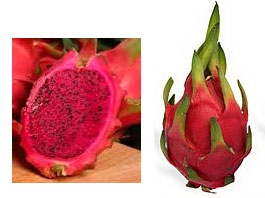The Tatura system of growing fruit is once again coming to the fore with a cactus fruit in north Queensland.
The cactus fruit is Pitaya, a native to Mexico, and is now grown in Central America, east Asia and south-east Asia, Indonesia, southern China, Hawaii, and Israel as well as in Queensland and northern NSW.
Pitaya has become a major fruit crop in Vietnam where it was given the name ‘Dragon Fruit’. We use this name in Australia.
Flowering
Dragon Fruit produces flowers overnight that usually wilt by late morning.
The large fragrant flower has a typical shape of a cactus flower and is called ‘Queen of the Night’.
Nocturnal pollinators such as bats and moths, pollinate the flowers. Native bees and the European honeybee also pollinate the flowers which stay open until about 9 a.m.
Flowers set fruit on the succulent stems. Fruit is harvested 30 to 50 days after fertilisation. The plants can flower five to six times in a year, depending on growing conditions.
Fruit
The fruit has a leathery leafy skin, which is not edible.
The two types of Dragon Fruit in Australia have white or red flesh with tiny black seeds. The taste is bland, like a melon or kiwifruit but mildly sweet, a cross between kiwifruit and pear.
The brilliant red variety has great appeal when used to decorate fruit salad, or garnish all kinds of desserts. The flesh is high in fibre, vitamins C and B.
T-trellis
Dragon Fruit is planted as mature pieces of succulent stems, each about a metre long.
The Dragon Fruit is conventionally grown on T-trellis, 1.6 to 2.0 m tall, spaced 3.0 m apart, with rows 4.0 or 4.5 m wide (833–740 trellis poles per hectare).
At the top of each pole are two pieces of timber 1.2 m long in the shape of a cross, over which the plants are draped. Each post may have two to four cuttings, which can start bearing fruit within 12 months, and can become fully productive within five years.
However, plants on T-trellis can become top-heavy, and plants and fruit can be damaged by strong winds and cyclones.
A better trellis option
On the other hand, Dragon Fruit is an ideal plant for a modified Open Tatura for the following reasons.
- The green succulent stems photosynthesise. There are no leaves to shade stems and fruit extensively
- The plants are vigorous and branch willingly, allowing an orderly arrangement of main stems and branches to quickly maximise canopy surface area
- Propagation from cuttings is cheap, allowing a density of 4444 plants per hectare for high early yields (4.5m x 0.5m)
- The two plane canopies of each trellis row make it easy to manage the plants and to harvest the fruit
- The Open Tatura can withstand a category-5 cyclone
- The trellis, together with the high-density planting and plane canopies allow cropping to be regulated, and frequency of flowering and fruiting to be increased with artificial light.
- The Open Tatura design
- The 3.0 m CCA-treated pine poles are spaced at 6.0 m with a cross-bar on each frame.
- The poles are angled at 22.5 degrees to the vertical.
- The trellis has four wires on each side. In the centre of each frame is a 3.6 m vertical pole with a central wire spanning these poles (total of nine wires).
- The two top wires and the central wire are insulated with polyethylene tubing to prevent the leaders from breaking off when they are draped over these wires.
- Anchors are of the ‘dead man’ type or are screw anchors.
Continued next month
See this article and images in Tree Fruit May 2014






















